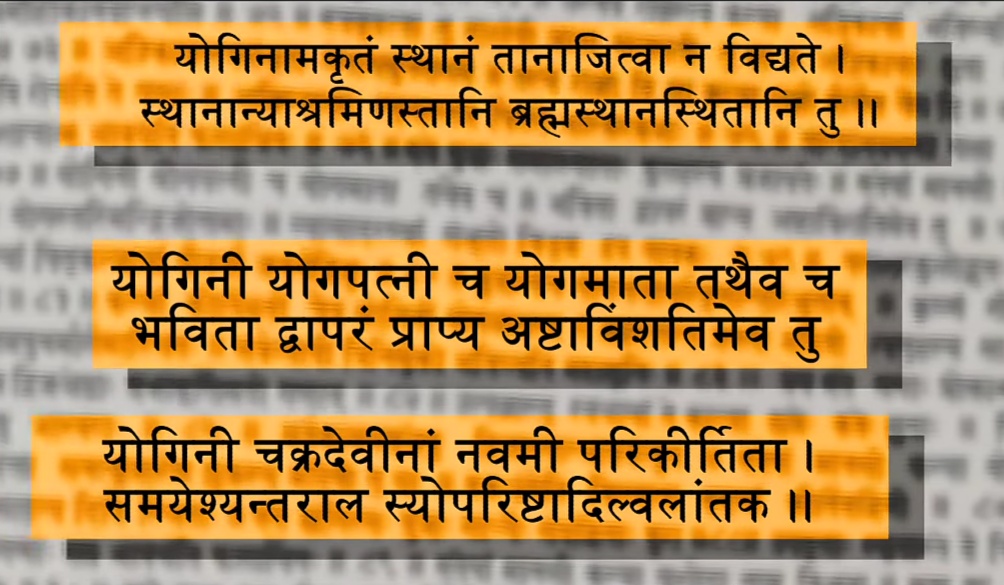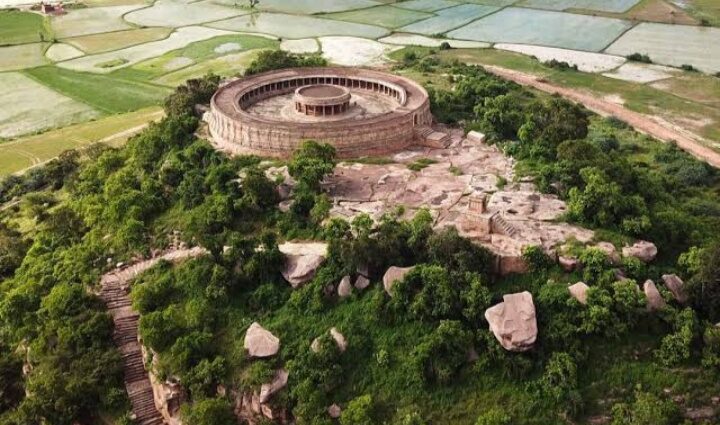In stark contrast to the Abrahamic occidental worldview Dharmic indigenous cultures have always been worshipping different manifestations of the feminine. In Bhāratam this started as the worship of Grama Devis (Village tutelary goddess) & Kul Devis (family lineage goddess). The Belan Valley in Uttar Pradesh has been identified as an ancient mother goddess figurine. The Kaimur hills show evidence of circular rubble platforms & worshipping of triangular stones as icons of the female principle.
The Vedic period informs about goddesses like Sinivali, Ida, Aditi, Raka, and Usha. Tattiriya Aranyaka provides instances of Durga-Gayatri. In Mahabharata Arjuna & Yuddhisthir recite Durga strota. Harivamsha mentions Durga as Aarya Narayani Tribhuvaneshvari, Shri Ratri Katyayani & Kaushiki. Sonkh sculpture in Mathura (UP) represents Durga as Mahishasurmardini. Kalika Puran mentions celebration of popular festival Durga Pooja. Udaygiri Ellora & Badami caves show evidence of Shakti worship. In a country that shows unflinching devotion to feminine a sub-section of Shaktism, Yogini has been often misunderstood or loosely interpreted because of the limited details which common folk can avail. It is an absolutely esoteric sect that had disappeared for the longest time. Publicly nobody knew about it, the Yogini temples and shrines were rediscovered later in the 19th century, which is just absolutely fascinating.
” I was afraid when I first read & felt of them but then it triggered me when something precious is there it is disguised in awe & fear,” says Veena Unnikrishnan, a scholar in the field from Kerala.
WHO IS A YOGINI?
(योगिनी).—Women endowed with supernatural powers (yoginī).
A Yogini is, literally, a female practitioner of Yoga.

अदृश्या दृश्यरहिता विज्ञानी वैद्यवर्जिता
योगिनी योगदा योग्या योगानन्दा युगन्धरा.
She who cannot be seen, who sees things from a different perspective, who is well versed in science, who is not in need to know something & is namesake to Yoga.
She represents one part of the universal divine energy that exists in all things. This is the feminine part while the other part is the masculine. The Chausath Yoginis were feared & worshiped for Tantric power. The sect of the Yoginīs was very powerful between the 9th and 12th centuries AD
.
Human yoginīs form a subtype of the general category of yoginī. Yoginīs or female spirits possessing superhuman powers are said to be divine or semi-divine as per the extent of evolution. (Siddhayogesvarīmata 22.5)
One can in fact distinguish between three subcategories of yoginīs:
1. Divine yoginīs who are identified with mantra syllables;
2. Semi-divine yoginīs who are invoked.
3. Human yoginīs who are said to belong to lineages or clans.
The basic typology lists seven types of human yoginīs, who must be recognized and identified through particular features. The seven types, called lineages or clans (kula), are based on the names and traits of the seven mother goddesses:
Brāhmī,
Māhesvarī,
Kaumārī,
Vaiṣṇavī,
Vārāhī,
Aindrī,
Chāmuṇḍā (or Mātṛnāyikā),
All seven types are described in Brahmayāmala as well as in a long chapter on various yoginīs in the somewhat later Tantrasadbhāva. The Siddhayogeśvarīmata includes only the first five types. The same yoginī types appear in later texts too, such as in the Jayadrathayāmala.
Yoginī (योगिनी) also refers to a “yogi-natured woman”, according to the 13th-century Matsyendrasaṃhitā: a Kubjikā-Tripurā oriented Tantric Yoga text of the Ṣaḍanvayasāmbhava tradition from South India.
SHIV PURANA
Yoginī (योगिनी) refers to a group of deities who together with the nine Durgās participated in Vīrabhadra’s campaign against Dakṣa, according to the Śivapurāṇa. Accordingly, as Brahmā narrated to Nārada: “Mahākālī went ahead for the destruction of Dakṣa accompanied by nine Durgās. The host of Yoginīs with their sixty-four groups set out angrily and hurriedly to destroy Dakṣa’s sacrifice.
Yoginī (योगिनी).—A Varṇa sakti :an attendant on Shiva.
The Goddes -who stands in Kanakhalatīrtha and dances with Shiva.
IN JAINISM
Yoginī (योगिनी) refers to a class of deities found in certain Jain manuscripts, possibly serving as attendants of Kṣetrapāla (the chief of the Bhairavas)—Some of the names are in common with the Brahmanic names of Yoginīs but a majority of them are quite original to Jainism.
IN BUDDHISM
Yoginī (योगिनी) refers to one of the twenty-four names of the Lāmās, according to the 8th-century Jayadratha-yāmala.
THE CHAUSATH YOGINĪ
Yoginīs are group divinities, they are worshipped in a group, like 64, 42, 81. It is not unusual in the Hindu context, we do have group divinities like the Sapta matrikas & Yakshīnīs.
The demon king Raktabija whose blood, if spilled, could create thousands of evil offspring. When Durga clashed with this seemingly invincible asura, she unleashed 64 yoginis—feminine beings who drank all his blood to the last, before it ever touched the ground. From this legend sprung the sect of the Chausath Yoginīs. The tribals in the old Gondwana forests of Central India were the original devotees of the Chausath. Sometime in the 8th century AD, the Chausath Yoginis moved into Tantric practices. Ultimately, the traditional Hindu pantheon of Gods and Goddesses came to include the Chausath.
64 Yoginīs according to Kālikāpurāṇa:
Kameśvarī, Guptadurgā, Vindhyakandaravāsinī , Koṭeśvarī, Dirghikā , Prakaṭī , Bhuvaneśvarī , Ākāshagaṅgā , Kāmākhyā , Dikkaravāsinī, Mataṅgī , Lalitā , Durgā , Bhairavī, Siddhidā, Balapramathinī, Chaṇḍiī, Chaṇḍogrā, Chaṇḍanāyikā, Ugrā, Bhīmā , Śivā, Śāntā, Jayanti, Kālikā, Maṅgalā, Bhadrakālī,
Dhātrī, Kapālinī, Svāhā, Svadhā, Aparṇā, Pañcapuṣkariṇī ,Damanī , Manaḥprotsāhakāriṇī ,Śailaputrī , Kuṣmāṇḍī ,Kauśikī ,Umā ,Haimavatī ,Jayā,Vijayā ,Sāvitrī and several gupta yoginis.
LINKS WITH TANTRA
There are two main types of Tantra, one is Daksinachara and another called Vamachara.
Daksinachara, also called ‘white tantra’, involves several orthodox practices such as meditation, yoga, recitation of mantras, abishekam (ritual centred on a murti), yagam (ritual of fire) and yantras (sacred geometric figures, graphic meditation aids).
The Vamachara or ‘red tantra’ includes several rituals qualified as “impure” or as black magic by the profane such as the consumption of alcohol, the offering of animals and maithuna.
By being connected to the Kapalika and Kaula tantra, the worship of the 64 yoginis is part of this red tantra.
64 YOGINĪ TEMPLES ACROSS INDIA
Each clan of Chausath Yoginis had seven or eight matriarch leaders, the presence of clans has been identified by temples in states of Odisha, Madhya Pradesh, Uttar Pradesh and Tamil Nadu. There are 11 extant Chausath Yogini temples found across India out of which two are in Odisha, five in Madhya Pradesh, three in Uttar Pradesh and one in Tamil Nadu. The most prominent ones are Hirapur, Ranipur Jharial, Khajuraho, Bhedaghat, Mitauli, Dudahi, and Rikhiyan. Yogini images have been discovered from Shahdol, Hinglajgadh, Lokhari and Naresar.
The temple plans resemble a yoni patt on which a Shiva-linga rests. The circular Yoginī niches represent yoni- Patt & Bhairava at centre represents Shiva-linga.
MITAOLI MORENA MP

Ekattarso Mahadeva
This circular shaped hypaethral structure runs about 125ft in diameter, with pillars running along the outer wall as well as the central shrine. These were the kind of features that identified a shrine to be a yogini’s place of worship. This temple, also known as Ekattarso Mahadeva Temple, was built by Kachchhapaghata king Devapala in 1323. This was a time, between the 9th and 13th centuries, when the semi divine goddesses were widely recognised and worshiped in the religious landscape. This temple has 64 chambers in its interior, each dedicated to a yogini or bhairavi. The structure that leads the eye to the sky holds another secret under its ground—a humongous water storage facility. The main shrine consists of a slab covered with perforations to drain excessive rainwater. A network of pipes runs around it, evidence of the engineering marvel lain bare for passersby to witness. The open air plan of the structure was built keeping cosmic sciences in mind and was used for educational purposes.
HIRAPUR ODISHA

The temple of Hirapur is highly isolated, with the only way to access it being through one small dirt lane. This temple is located between Bhubaneshwar and Puri—Ekamrakshetra and Prurshottamakshetra, both known to be prolific centres of tantrism in their times—in the Hirapur village of Khurda district, Odisha. The temple is built of coarse sandstone blocks with laterite in its foundation. The yoginis are carved out of fine-grained grey chlorite. The inner walls of the temples have 64 niches with 60 yoginis still in place. According to an 11th century Odia text Ekamracandrika, the temple at Hirapur was one of the Shakti pithas of Ekamra (Bhubaneshwar).
It was constructed by Queen Hira of Bhaumakara dynasty and the village takes its name from the queen.
Prominent tantric temples of Odisha were constructed during the reign of Bhaumakaras. The Bhaumakaras who came to power in the 8th century AD after replacing the Sailodbhavas, ruled over all of Odisha except the north-western region of Dakshin Kosala.
RANIPUR JHARIAL ODISHA

The Chausathi Yogini Pitha in Ranipur-Jharial, near towns of Titilagarh and Kantabanjhi in Balangir district, Western Odisha, is a larger hypaethral 64-yogini temple. 62 of the yogini images survive.At the centre is a shrine with four pillars, holding an image of Nateshwar, Shiva as Lord of Dance.
A dancing Martand Bhairava image has been found from shrine. ‘Martanda’ is one of the names of Sun god, and ‘Bhairava’ is a ferocious form of Siva who is associated with yoginis—this points towards a syncretic solar-cum-saiva tantric deity. The solar aspect of this temple could also be ascertained from the four faces of Martand Bhairava representing four directions.
KHAJURAHO MP

The 9th-10th century yogini temple at Khajuraho in Chhatarpur District, and is the oldest temple on the site. It is rectangular, unlike the other yogini temples, but like them is hypaethral. There is no sign of a central shrine, which was apparently housed in the niche, larger than the rest, opposite the entrance. It was constructed with 65 shrine cells, each with a doorway made of two squared granite pillars and a lintel stone, and each with a tower roof. 35 of the cells survive. It stands on a 5.4 metre high platform. Three squat images, of Brahmani, Maheshwari and Hingalaja (Mahishasurmardini), survived at the site and are on display in the museum.
81 YOGINĪ TEMPLES
BHEDAGHAT JABALPUR MP

The 10th-century Yogini temple is a shrine to 81 yoginis. It is the largest of the circular yogini temples, some 125 feet in diameter. There is a later shrine in the centre of the courtyard. The 81 images include 8 Matrikas & Mother goddesses.
42 YOGINĪ TEMPLES
BADOH VIDISHA MP

It is known as the Gadarmal temple of the Mothers and is one of the few that are rectangular. 18 broken images of the goddesses that once fitted into grooves in the temple platform are preserved from the waist down. It is composed of a rectangular shrine and a tall and massive Shikhara, adjacent to some Jain temples.
DUDAHI LALITPUR UP
The temple is locally named Akhada. It is now in ruins. Once had a circular plan with niches for 42 yoginis. The circle is 50 feet in diameter.

Several other Yoginī shrines which were in Lokhari & Rikhiya ( Banda UP), Nareshwar & Shahdol (MP) & Kaveripakkam near Kanchipuram (Tamil Nadu) are now lost.

French archeologist Gabriel Dubois and his Indian associate Thangavelu Pillai discovered most of the sculptures around Kanchipuram between 1925 and 1926. The site of Hinglajgarh, on the border of MP and Rajasthan, was cleared of statuary for the building of the Gandhi Sagar Dam.
SOURCES :
1. Gadon, Elinor. ‘Probing the Mysteries of the Hirapur Yoginis’.
2. Mahapatra, K. N. 1953. ‘A Note on the Hypaethral Temple of Sixty-four Yoginis at Hirapur,’ Orissa Historical Research Journal.
3. Yoginī : Unfolding the goddess within Shambhavi Lorain Chopra
Images sourced from internet.
![]()
- BHĀRAT: EVOLUTION OF A DYNAMIC & DIVINE RĀSHTRA - September 12, 2023
- ECHOES OF INDIC FACETS EMBEDDED IN JAPANESE CULTURE - July 7, 2023
- YOGINIS: SACRED FEMININE DIVINITY & ENLIGHTENMENT - May 25, 2023

